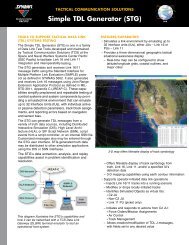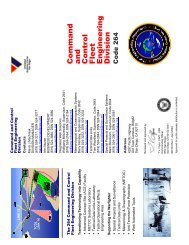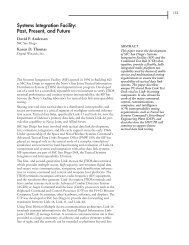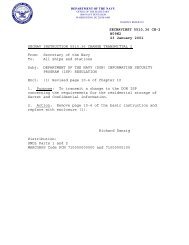Intelligence, Surveillance, and Reconnaissance - Spawar
Intelligence, Surveillance, and Reconnaissance - Spawar
Intelligence, Surveillance, and Reconnaissance - Spawar
Create successful ePaper yourself
Turn your PDF publications into a flip-book with our unique Google optimized e-Paper software.
168<br />
An Artificial-Neural-Network Multiple-Model<br />
Tracker<br />
Mark W. Owen<br />
SSC San Diego<br />
INTRODUCTION<br />
The Robust Tracking with a Neural Extended Kalman Filter (NEKF)<br />
project is an Office of Naval Research (ONR) In-house Laboratory<br />
Independent Research (ILIR)-sponsored effort at SSC San Diego. The<br />
project’s goal is to provide an improved state estimation capability for<br />
current U.S. Navy tracking systems. The NEKF will provide added capability<br />
for the real-time modeling of maneuvers <strong>and</strong>, therefore, will<br />
enhance the ability of tracking systems to adapt appropriately.<br />
Extended Kalman filters using neural networks have been utilized in the<br />
past in control-system technology <strong>and</strong> for system identification [1 <strong>and</strong> 2].<br />
This paper details how the NEKF can be incorporated into an interacting<br />
multiple-model tracking architecture to provide robust tracking capabilities<br />
that are currently unavailable.<br />
BACKGROUND<br />
State estimation <strong>and</strong> tracking of highly maneuvering targets are extremely<br />
difficult tasks in modern tracking systems. Current state estimation<br />
approaches to the tracking problem include alpha–beta filters, Kalman filters,<br />
interacting multiple-model (IMM) filters, probabilistic data association<br />
(PDA) trackers, <strong>and</strong> joint PDA (JPDA) trackers [3 <strong>and</strong> 4]. State estimation<br />
is the problem of deriving a set of system states that are of interest<br />
to a system or decision-maker. System states consist of parameters<br />
such as position, velocity, frequencies, magnetic moments, <strong>and</strong> other<br />
attributes of interest. Most often, system states are not measurable at the<br />
system output. For example, range <strong>and</strong> bearing of a target may be available<br />
from a radar sensor, but the position <strong>and</strong> velocity of the target need<br />
to be derived from the radar measurement. To derive these states, an estimation<br />
algorithm is used. A mathematical system model is necessary for<br />
the aforementioned filter algorithms to perform state estimation.<br />
Kalman Filter<br />
A well-known state estimation algorithm is the Kalman filter developed<br />
four decades ago by R. E. Kalman [5]. The Kalman filter is widely used in<br />
government <strong>and</strong> industry tracking problems. The Kalman filter uses an<br />
assumed mathematical system model (i.e., a straight-line motion model<br />
for an aircraft) to estimate the states (position, velocity, signatures, etc.) of<br />
an aircraft. A Kalman filter consists of the dynamic system to be tracked,<br />
a mathematical system model, an observation model, the Kalman gain, a<br />
ABSTRACT<br />
A neural extended Kalmanfilter<br />
(NEKF) algorithm was<br />
embedded in an interacting<br />
multiple-model architecture<br />
for target tracking. The NEKF<br />
algorithm is used to improve<br />
motion-model prediction during<br />
maneuvers. With a better<br />
target motion mode, noise<br />
reduction can be achieved<br />
through a maneuver. Unlike<br />
the interacting multiple-model<br />
architecture that uses a highprocess<br />
noise model to hold a<br />
target through a maneuver<br />
with poor velocity <strong>and</strong> acceleration<br />
estimates, an NEKF<br />
is used to predict the correct<br />
velocity <strong>and</strong> acceleration states<br />
of a target through a maneuver.<br />
The NEKF estimates the<br />
weights of a neural network,<br />
which, in turn, is used to<br />
modify the state estimate<br />
predictions of the filter as<br />
measurements are processed.<br />
The neural-network training<br />
is performed online as data are<br />
processed. This paper provides<br />
the results of an NEKF embedded<br />
in an interacting multiplemodel<br />
tracking architecture.<br />
Highly maneuvering threats<br />
are a major concern for the<br />
Navy <strong>and</strong> Department of<br />
Defense (DoD), <strong>and</strong> this<br />
technology will help<br />
address this issue.









